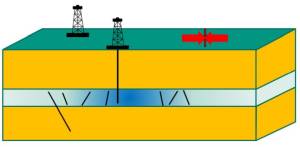When constructing geothermal systems for the extraction of heat from underground hot water reservoirs, optimal positioning of the boreholes can considerably reduce seismicity. This is the result of induced seismicity studies by scientists of Karlsruhe Institute of Technology (KIT). Induced seismicity means shocks caused by human activities. Based on the change of water pressure in the rock (pore pressure) and the mechanical stresses in the rock, the researchers modeled changes of the stress field as a result of the injection and extraction of fluids, e.g. gases or liquids. This is reported in the journal ERDÖL ERDGAS KOHLE. (DOI: 10.19225/180106)
Injection of liquids into the underground e.g. at geothermal facilities, when injecting wastewater, or for the geological storage of carbon dioxide as well as the removal of fluids for e.g. natural gas production may cause noticeable tremors. These earthquakes caused by human activities (induced seismicity) are based on mechanical principles: Both injection and extraction change the pore pressure, i.e. the water pressure, and, hence, the stress state in the rock. As a result, natural fracture surfaces in the underground may be displaced relative to each other, similar to a small natural earthquake.
Based on this poroelastic coupling of pore pressure and stress, Dr. Birgit Müller und Professor Frank Schilling of KIT’s Institute of Applied Geosciences and the State Geothermal Energy Research Center located at KIT have now studied the seismicity induced by injection and extraction. The project was carried out in cooperation with researchers of the German Research Centre for Geosciences (GFZ) in Potsdam and the engineering office Piewak & Partners, Bayreuth. “For disruptions in the underground of variable orientation, such as fracture surfaces, it is possible to calculate whether induced seismicity can be expected to result from geoengineering activities. From this, recommendations can be derived for the positioning of boreholes and production operation in order to reduce the risk of induced seismicity,” Dr. Birgit Müller summarizes the results published in the journal ERDÖL ERDGAS KOHLE.
The findings are of high relevance to hydrothermal systems for the use of deep geothermal energy, which extract heat from the hot water circulating in an underground reservoir. Water is pumped out at one point and, after cooling down, injected into the ground again at another point. “Our modeling results show that the probability and extent of induced seismicity in hydrothermal systems can be reduced significantly by an active pore pressure management in the reservoir as well as by optimal positioning of the boreholes relative to the orientation of tectonic stresses,” Dr. Birgit Müller says.
B. Müller, F. Schilling, Th. Röckel, and O. Heidbach: Induced Seismicity in Reservoirs: Stress Makes the Difference. ERDÖL ERDGAS KOHLE, Heft 1/2018. DOI: 10.19225/180106
More about the KIT Energy Center: http://www.energy.kit.edu
Being “The University in the Helmholtz Association”, KIT creates and imparts knowledge for the society and the environment. It is the objective to make significant contributions to the global challenges in the fields of energy, mobility, and information. For this, about 10,000 employees cooperate in a broad range of disciplines in natural sciences, engineering sciences, economics, and the humanities and social sciences. KIT prepares its 22,800 students for responsible tasks in society, industry, and science by offering research-based study programs. Innovation efforts at KIT build a bridge between important scientific findings and their application for the benefit of society, economic prosperity, and the preservation of our natural basis of life. KIT is one of the German universities of excellence.

